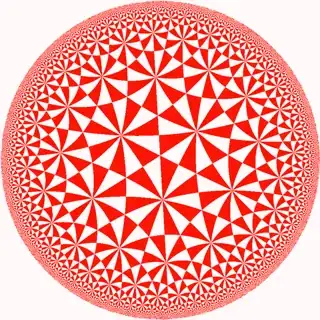I am reading a paper on continued fractions and it uses the following result on Lie Groups:
Fix an arbitrary left-invariant metric $d$ on $PSL_2(\mathbb{R})$ ...
This phrase really throws me off... How many such left-invariant metrics are there? Consider two maps,
$$ z \mapsto \frac{a_0z+b_0}{c_0z+d_0} , \hspace{0.25in}z \mapsto \frac{a_1z+b_1}{c_1z+d_1} $$
each with $ad-bc=1$, what is the appropriate notion of distance here?
Can someone illustrate two non-equivalent left-invariant metrics on the space of Fractional Linear Transformations?
If it is easier, I will mysteriously ask for different (non-equivalent) metrics on $T^1(\mathbb{H}) \simeq PSL_2(\mathbb{R})$
These are not points in the Hyperbolic plane, these are geodesics in the hyperbolic plane. In the picture below you can see semi-circles in the checkered pattern below, these can be identified with unit tangent vectors
related
- Expression of the Hyperbolic Distance in the Upper Half Plane
- Description of SU(1, 1)
- What are elements in $SU(1, 1)$?

There's some question of what I mean by "equivalent" "metric" (along the lines of Bill Clinton's what does "is" mean?) I am just trying to see if there are really any "different" left-invariant metrics.
Left invariant is pretty restrictive. I believe in the case of $\mathbb{H}$ hyperbolic plane there is only one translation invariant constant curvature metric up to scalar multiplication (so we can set curvature to -1).
My bst guess for $T^1(\mathbb{H})$ is $\frac{dx^2 + dy^2}{y^2} + d\theta^2 $ where $\theta$ is the angle of the unit tangent vector.
Is the left-invariant metric on $T^1(\mathbb{H})=PSL_2(\mathbb{R})$ unique up to scalar multiplication ?